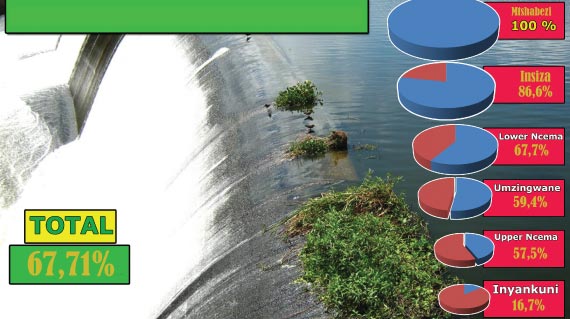
THE INCESSANT rains that have been pounding most of the country has left a number of dams spilling, Bulawayo’s second largest dam Inyankuni is only 15,6% full.
Nqobile Bhebhe Chief Reporter
Upper Ncema, Lower Ncema and Umzingwane are also far from reaching their full capacity leaving many asking questions about the city’s future water supplies.
As of Friday, the supply dams had a combined 67,71% capacity with Mtshabezi Dam the only one among the six that is already spilling.
Bulawayo senior public relations officer, Nesisa Mpofu said other dams were not likely to be filled to capacity despite the record rainfall due to a small catchment area and siltation.
“Inyankuni dam is the second largest of the council’s dams. It has a design capacity of 80,781,000 cubic metres, but has a relatively small catchment hence it takes long to fill up,” she said.
“Council does not have capacity to dredge (de-silt) the dams and therefore this exercise has never been done by council before. “In the country as a whole, it is only Zinwa (Zimbabwe National Water Authority), which has recently acquired two dredging machines for use in dredging dams.”
Mpofu said council would remain vigilant in ensuring water consumption is maintained at a reasonable levels. She said council had only suspended its water shedding programme, but would continue rationing water. According to council, water shedding is a programme adopted by a water authority to ensure that all residents have access to an equal amount of water. The programme is carried out after noting that water supplies to an area are not adequate to meet demand.
- Chamisa under fire over US$120K donation
- Mavhunga puts DeMbare into Chibuku quarterfinals
- Pension funds bet on Cabora Bassa oilfields
- Councils defy govt fire tender directive
Keep Reading
“The six supply dams are currently holding a combined 67.71% of their combined design capacity against 43.1% when the city introduced water shedding in July 2012,” she said.
“The rainy season is now halfway through and therefore there is a good possibility that the dam levels may increase further before the end of the season.
“At present council has only resolved to suspend water shedding while water rationing remains in force and both are subject to review at the end of the rainy season (March/April).”
Water rationing limits in low density areas is still pegged at 350 litres per day, high density (300 litres per day), cottages (200 litres per day) and residential flats with individual meters limit is 300 litres.










